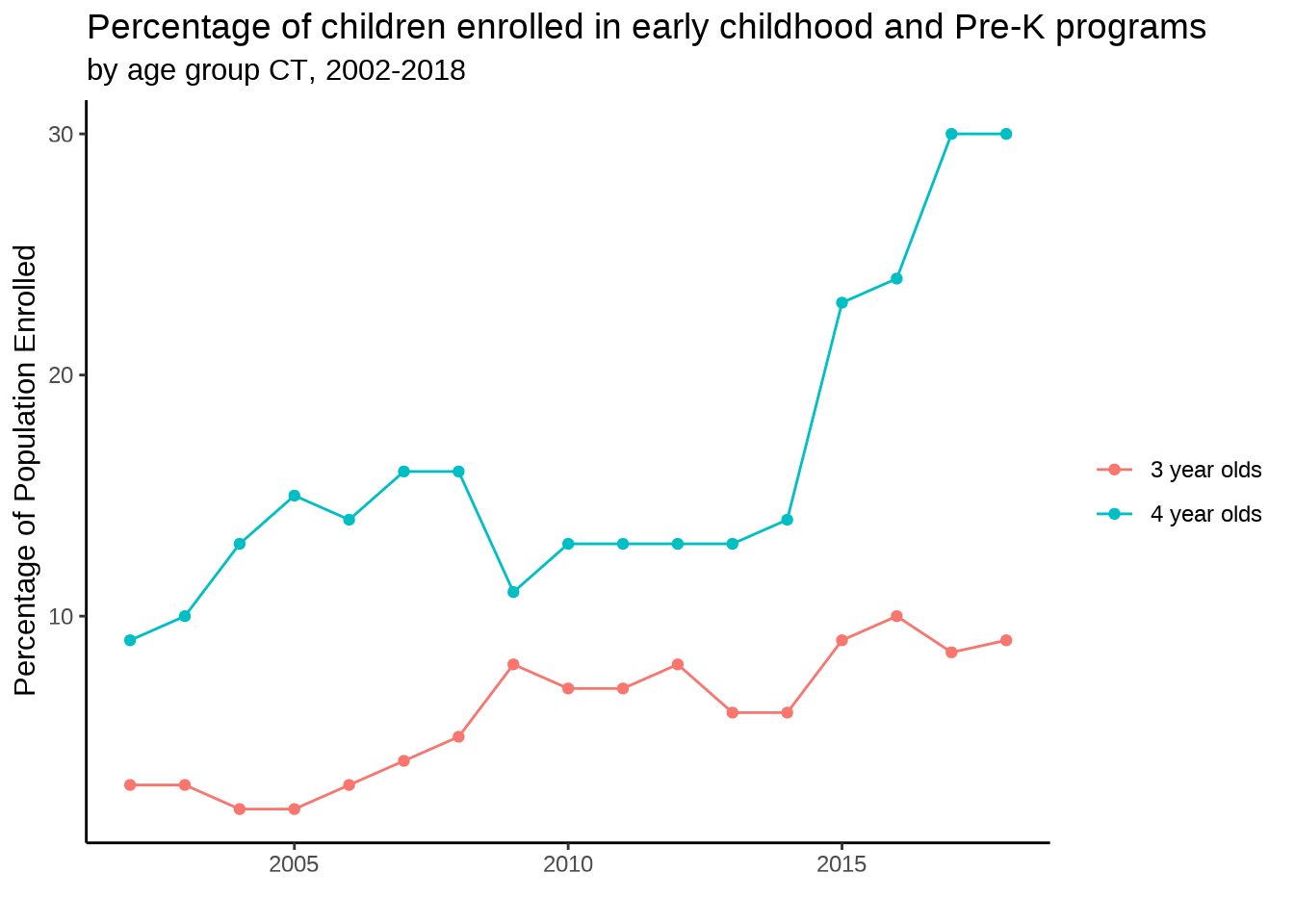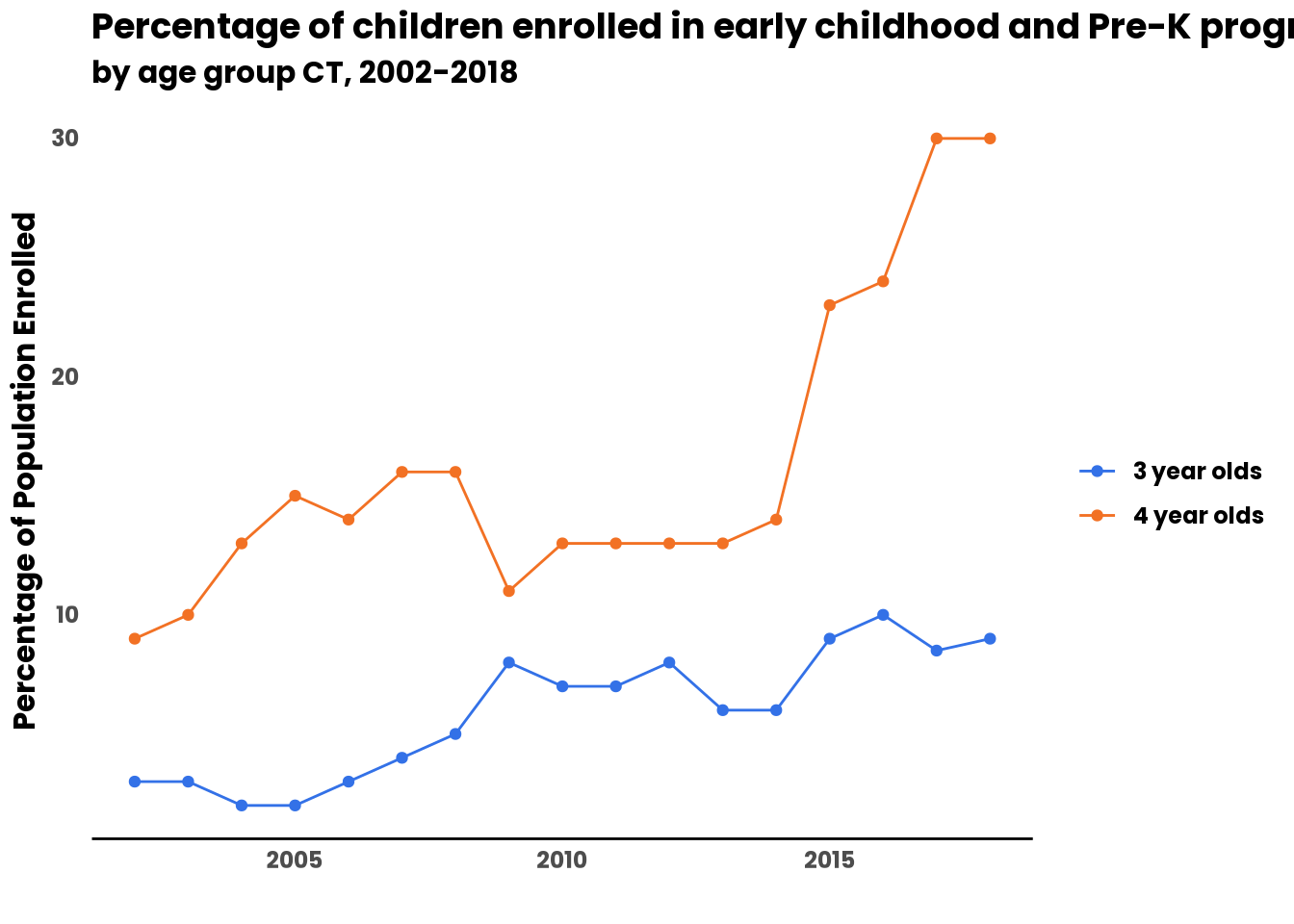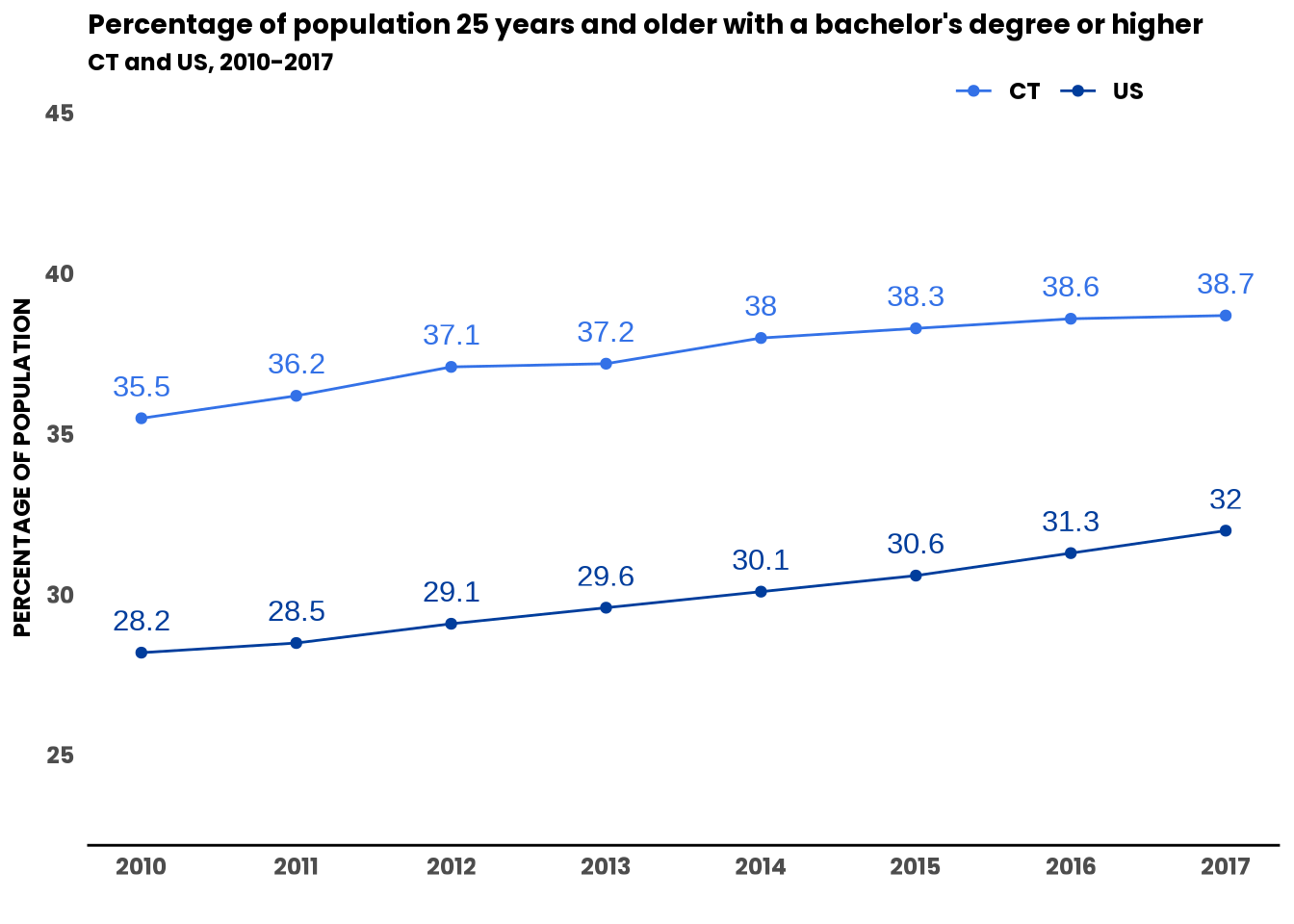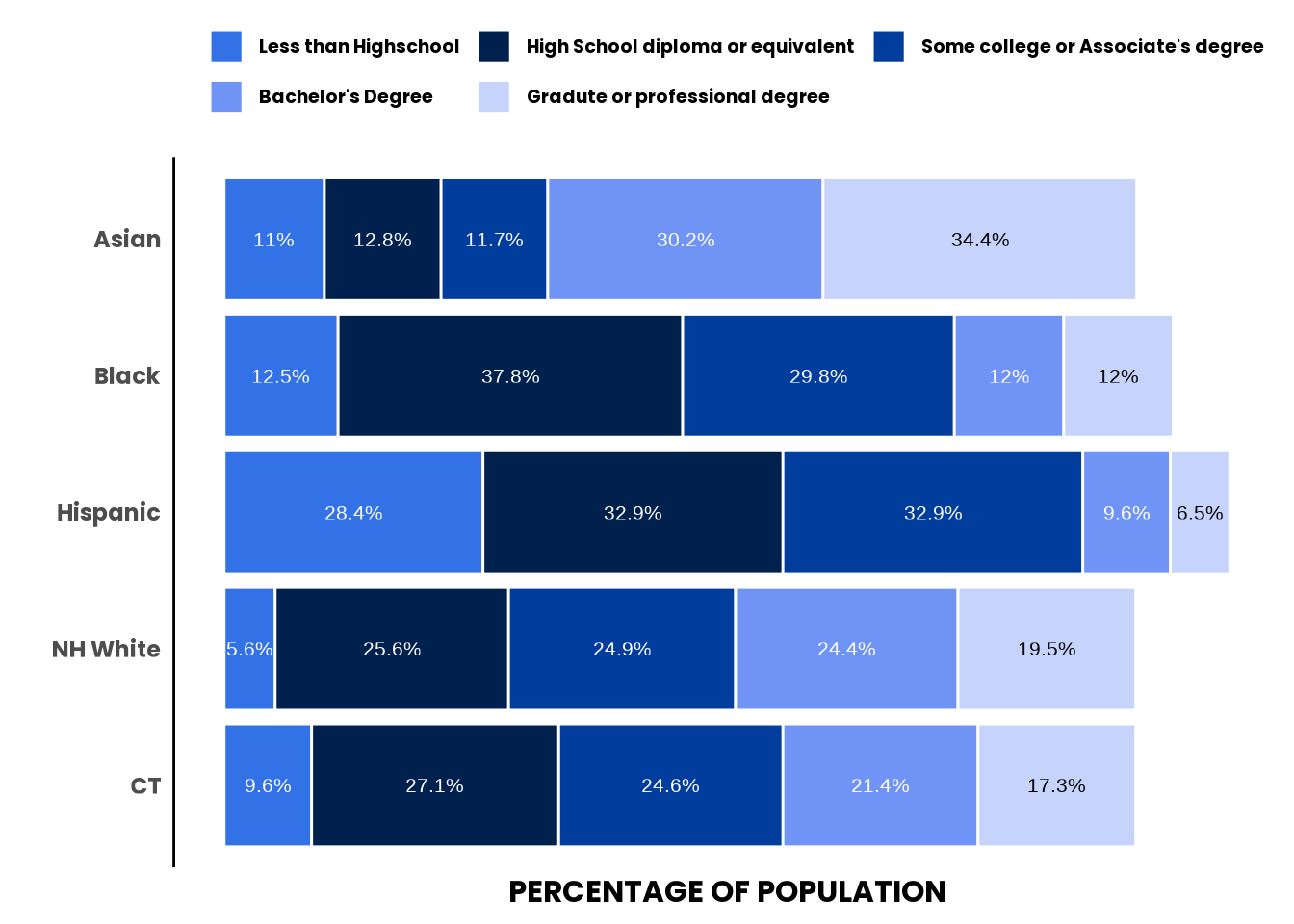
4 Social Factors
The Social Determinants of Health (SDOH) are the upstream non-health factors that “impact a wide range of health, functioning and quality of life outcomes.” For public health, this is as preventive as it gets. When considering these upstream factors in the work of a public health entity such as the Connecticut Department of Public Health (CT DPH), we can more effectively inform the public and policymakers so we can all live better lives. As an agency whose mission declares that the equal enjoyment of a person’s highest attainable standard of health is a human right, we must also examine the conditions that contribute to “avoidable differences in health among specific population groups that result from cumulative social disadvantages.”(John J. Smith 2018) More specifically, we apply an equity lens to ascertain which populations are being most negatively impacted.1
References can be tracked and managed using BibTeX2 and then quarto will convert it into a reference page and link it all through the document. It almost feels like magic. The orginal SHA document was around 400 pages long and it could be hard to find the references and then jump back to the original spot where the reader left off. Here the references show up on hover and clicking on them brings the user to the reference page, which can easily be opened into another tab, thus reducing alot of friction when interacting with the SHA.
4.1 Education
Economic factors such as poverty and unemployment can lead to unhealthy living conditions. Yet education can provide individuals with foundational knowledge, life skills, and social and psychological supports to make healthier choices. Therefore, quality education and higher educational attainment can be a protective factor that can advance more equitable outcomes(2021). It has been demonstrated that individuals without a high school diploma have higher incidences of risk behaviors and other adverse health outcomes; and earn less money, which can limit access to resources and healthy environments(2023).
4.1.1 Early Education
Experiences and education within the first five years of life can shape one’s health trajectory across the lifespan. Early education and care programs can be protective against social and economic challenges and narrow inequitable gaps in health outcomes.5 Participating in these programs are also associated with higher educational attainment, better eating habits, increased use of preventive healthcare services, and lower rates of child injuries, child abuse/maltreatment, teen pregnancy, depression, use of tobacco or other drugs, and arrests and incarceration.
As noted in Figure 4.1, the rate of Pre-K enrollment for 4-year old children in state-funded preschool programs in Connecticut has made sizable gains over the past 5 years; however, enrollment among 3-year old children has remained fairly stable over the past decade and thus far peaked at 10% in 2016.
Did you see how the chart pops up on mouse hover? Pretty cool! While mostly a fun novelty here, in a 400 page document this can allow authors to provide rich details and context around their data and narratives.
CONNECTICUT RANKS NINTH IN THE US FOR EARLY EDUCATION SPENDING PER CHILD3
Connecticut has three state-funded pre-kindergarten programs: School Readiness Program, Child Day Care Contracts, and Smart Start4
In 2018, 14,585 children were enrolled in state pre-kindergarten programs5
On average, our state spent $7,612 per child enrolled; this reflects a 30% drop in average per child expenditure since 20116
According to most recent estimates available (2013–2014 school year), children enrolled in CT early childhood and pre-kindergarten programs were:7
50% are non-Hispanic White, 26% are Hispanic/Latino, 15% are non-Hispanic Black or African American, and 5% are non-Hispanic Asian
23% are students with disabilities served under the Individuals with Disabilities Education Act
2% are English Language Learners (those who speak English less than “very well;” for more information about Limited English Proficient section)

Now the same plot with similiar themeing to the original plot, but now with CT approved colors and poppin font.

4.1.2 Education Attainment
In an age-adjusted multivariate analysis of the entire US, it was demonstrated that lack of high school education captured the effect of income inequality in addition to contributing to increased mortality that is attributed to increased risk of injury as a result of high-risk occupations, inadequate health insurance coverage, and unhealthy behaviors like smoking.6
In Connecticut, one in ten residents aged 25 and older have earned less than a high school degree, which is slightly less than the national proportion (Figure 4.3). As a state, nearly two in five residents 25 and older earned a bachelor’s degree and above in 2017, exceeding the national rate.
Fairfield County had the greatest percentage of its residents with at least a bachelor’s degree (47%) while residents from Windham County experienced the lowest percentage (24%); unsurprisingly, Fairfield County also has the most towns — 10 out of 23 — with median household incomes exceeding $125,000.
Etiam non efficitur urna, quis elementum nisi. Mauris posuere a augue vel gravida. Praesent luctus erat et ex iaculis interdum. Nulla vestibulum quam ac nunc consequat vulputate. Nullam iaculis lobortis sem sit amet fringilla. Aliquam semper, metus ut blandit semper, nulla velit fermentum sapien, fermentum ultrices dolor sapien sed leo. Vestibulum molestie faucibus magna, at feugiat nulla ullamcorper a. Aliquam erat volutpat. Praesent scelerisque magna a justo maximus, sit amet suscipit mauris tempor. Nulla nec dolor eget ipsum pellentesque lobortis a in ipsum. Morbi turpis turpis, fringilla a eleifend maximus, viverra nec neque. Class aptent taciti sociosqu ad litora torquent per conubia nostra, per inceptos himenaeos.
Duis urna urna, pellentesque eu urna ut, malesuada bibendum dolor. Suspendisse potenti. Vivamus ornare, arcu quis molestie ultrices, magna est accumsan augue, auctor vulputate erat quam quis neque. Nullam scelerisque odio vel ultricies facilisis. Ut porta arcu non magna sagittis lacinia. Cras ornare vulputate lectus a tristique. Pellentesque ac arcu congue, rhoncus mi id, dignissim ligula.
4.2 Neighborhood and Built Environment
4.2.1 Access to Health Foods
Aenean placerat luctus tortor vitae molestie. Nulla at aliquet nulla. Sed efficitur tellus orci, sed fringilla lectus laoreet eget. Vivamus maximus quam sit amet arcu dignissim, sed accumsan massa ullamcorper. Sed iaculis tincidunt feugiat. Nulla in est at nunc ultricies dictum ut vitae nunc. Aenean convallis vel diam at malesuada. Suspendisse arcu libero, vehicula tempus ultrices a, placerat sit amet tortor. Sed dictum id nulla commodo mattis. Aliquam mollis, nunc eu tristique faucibus, purus lacus tincidunt nulla, ac pretium lorem nunc ut enim. Curabitur eget mattis nisl, vitae sodales augue. Nam felis massa, bibendum sit amet nulla vel, vulputate rutrum lacus. Aenean convallis odio pharetra nulla mattis consequat.

Lorem ipsum dolor sit amet, consectetur adipiscing elit. Duis sagittis posuere ligula sit amet lacinia. Duis dignissim pellentesque magna, rhoncus congue sapien finibus mollis. Ut eu sem laoreet, vehicula ipsum in, convallis erat. Vestibulum magna sem, blandit pulvinar augue sit amet, auctor malesuada sapien. Nullam faucibus leo eget eros hendrerit, non laoreet ipsum lacinia. Curabitur cursus diam elit, non tempus ante volutpat a. Quisque hendrerit blandit purus non fringilla. Integer sit amet elit viverra ante dapibus semper. Vestibulum viverra rutrum enim, at luctus enim posuere eu. Orci varius natoque penatibus et magnis dis parturient montes, nascetur ridiculus mus.
4.2.2 Food Insecurity
Duis ornare ex ac iaculis pretium. Maecenas sagittis odio id erat pharetra, sit amet consectetur quam sollicitudin. Vivamus pharetra quam purus, nec sagittis risus pretium at. Nullam feugiat, turpis ac accumsan interdum, sem tellus blandit neque, id vulputate diam quam semper nisl. Donec sit amet enim at neque porttitor aliquet. Phasellus facilisis nulla eget placerat eleifend. Vestibulum non egestas eros, eget lobortis ipsum. Nulla rutrum massa eget enim aliquam, id porttitor erat luctus. Nunc sagittis quis eros eu sagittis. Pellentesque dictum, erat at pellentesque sollicitudin, justo augue pulvinar metus, quis rutrum est mi nec felis. Vestibulum efficitur mi lorem, at elementum purus tincidunt a. Aliquam finibus enim magna, vitae pellentesque erat faucibus at. Nulla mauris tellus, imperdiet id lobortis et, dignissim condimentum ipsum. Morbi nulla orci, varius at aliquet sed, facilisis id tortor. Donec ut urna nisi.
Aenean placerat luctus tortor vitae molestie. Nulla at aliquet nulla. Sed efficitur tellus orci, sed fringilla lectus laoreet eget. Vivamus maximus quam sit amet arcu dignissim, sed accumsan massa ullamcorper. Sed iaculis tincidunt feugiat. Nulla in est at nunc ultricies dictum ut vitae nunc. Aenean convallis vel diam at malesuada. Suspendisse arcu libero, vehicula tempus ultrices a, placerat sit amet tortor. Sed dictum id nulla commodo mattis. Aliquam mollis, nunc eu tristique faucibus, purus lacus tincidunt nulla, ac pretium lorem nunc ut enim. Curabitur eget mattis nisl, vitae sodales augue. Nam felis massa, bibendum sit amet nulla vel, vulputate rutrum lacus. Aenean convallis odio pharetra nulla mattis consequat.
Ut ut condimentum augue, nec eleifend nisl. Sed facilisis egestas odio ac pretium. Pellentesque consequat magna sed venenatis sagittis. Vivamus feugiat lobortis magna vitae accumsan. Pellentesque euismod malesuada hendrerit. Ut non mauris non arcu condimentum sodales vitae vitae dolor. Nullam dapibus, velit eget lacinia rutrum, ipsum justo malesuada odio, et lobortis sapien magna vel lacus. Nulla purus neque, hendrerit non malesuada eget, mattis vel erat. Suspendisse potenti.
Oh man, the numbers don’t add up to 100% in the original picture in the SHA.

We can do footnotes that pop up on highlight, and that also show up at the bottom of the page! They can include citations too (and they can be shortened)(2018)↩︎
BibTeX is a format for storing references that is easy to convert to many other formats. Check out bibtex.org for more info.↩︎
Source: (John J. Smith 2021).↩︎
Source: (John J. Smith 2021).↩︎
Source: (John J. Smith 2021).↩︎
Source: (John J. Smith 2021).↩︎
Source: (John J. Smith 2021).↩︎